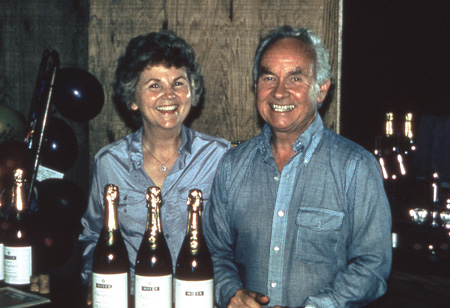
Was this even possible? When did this happen, you say? Well, we have to harken back decades well before the 2006 agreement between the European Union and the United States that restricted the labeling of wine names made for hundreds of years that are tied historically, geographically, and/or technically to specific regions of Europe. Let’s look to 1982 back when “Champagne” – or should I say, wine made by the specific process of Méthode Champenoise – was made in the Texas Hill Country and actually labeled Champagne.
Back in 1982, if we stood on the side of the road at I-35 and Post Road facing west, we would see a 7,000 square foot, pre-fab metal warehouse with 70,000 bottles of champagne aging inside. This unassuming “Domaine”, certainly not like the elegant one you see in northern France, was the home of Moyer Texas Champagne Company owned by Ken Moyer, then 62 years old. It is there where he popped the first bottle, tasted it and with a smile said, “It’s good!. I’ve been tasting it periodically and it’s been good for some time.”

As a short refresher, Champagnes are sparkling wines made by méthode champenoise which requires a secondary fermentation not in a tank or barrel, but directly in the bottle. This secondary fermentation is accomplished by adding a mixture of sugar and yeast, called the “liqueur de tirage”, to still wine. This wine is capped, with a cap similar to those found on beer or soda bottles – not a cork. The yeast acts on the sugar and the resulting carbon dioxide remains trapped in the bottle creating effervescence. These sparkling wines are usually left on their yeast for several months to years. At the end of this process, the wine in the neck of the bottle is frozen, the cap removed, yeast and sediment expurged, and the cap replaced with a traditional cork with a wire cage around it.
Back then, Moyer was making his sparkling wine in Texas and he was originally a native Texan and University of Texas engineering graduate. However, prior to starting this Texas winery, he was living in Manchester, Ohio, from which he moved his 10-year old champagne operation to the once-German settlement of New Braunfels, Texas. If we peeked inside Moyer’s warehouse-winery, according to the reports of the time, what we’d see is a receiving room with a large Star of Texas quilt hanging on the wall followed by a large cement room containing five large 1,100-gallon tanks and bottles of sparkling wine in various states of aging.
Like many previous and modern-day winemakers in Texas, Moyer began as an amateur winemaker. He made his early wines in his dormitory room at the University of Texas. According to Moyer, “It didn’t taste too bad.”
Being an engineer, Moyer considered ways to improve the efficiency of the Champagne-making process that commonly involves rotating by hand the bottles periodically during fermentation and aging. This process is called riddling. To facilitate this process, he built an automated riddling machine that took cartons of his aging wine onto the machine to periodically vibrate the cartons of unfinished wine. This innovation reduced both the wine and labor involved in the riddling process more compatible with a small winery operation like Moyer’s.
In the early 1980’s, the time of Moyer’s operation in Texas, grape growing was in its infancy. He found it better to make his wines by blending wines from California Chenin Blanc, Chardonnay, Colombard and Ugni Blanc (Trebbiano). In the 1980’s, the winery business in Texas was hard. Modern viticulture here was just beginning and laws that encouraged the sale of wine in Texas virtually non-existent. Eventually, while providing three cases of the Champagne bottled especially for the inauguration of President George H.W. Bush in 1989, Moyer decided to move back to Ohio. Moyer’s Texas winemaking legacy lived on at Hill Country Cellars then located near the intersection of Route 183 and FM 1431 in Cedar Park just north of Austin. In 1994, Hill Country Cellars purchased Moyer’s equipment, reportedly from Henri Bernabe who was the head of the family business Richter SA, and continued to make sparkling wines further into 1990s.

Ken Moyer, age 88, died at home in Manchester on July 9, 2008, surrounded by his wife and family. He is survived by his wife, Mary Moyer, with whom he recently celebrated their 60th wedding anniversary.
— — — — —
Credits: Moyer Texas Champagne photos – Ben Smusz (photographer – Texas Wines & Wineries by Frank Giordano, 1984). Text references from The Wines of Texas, 1st and 3rd editions, 1986 & 1995, by Sarah Jane English.
Be the first to comment